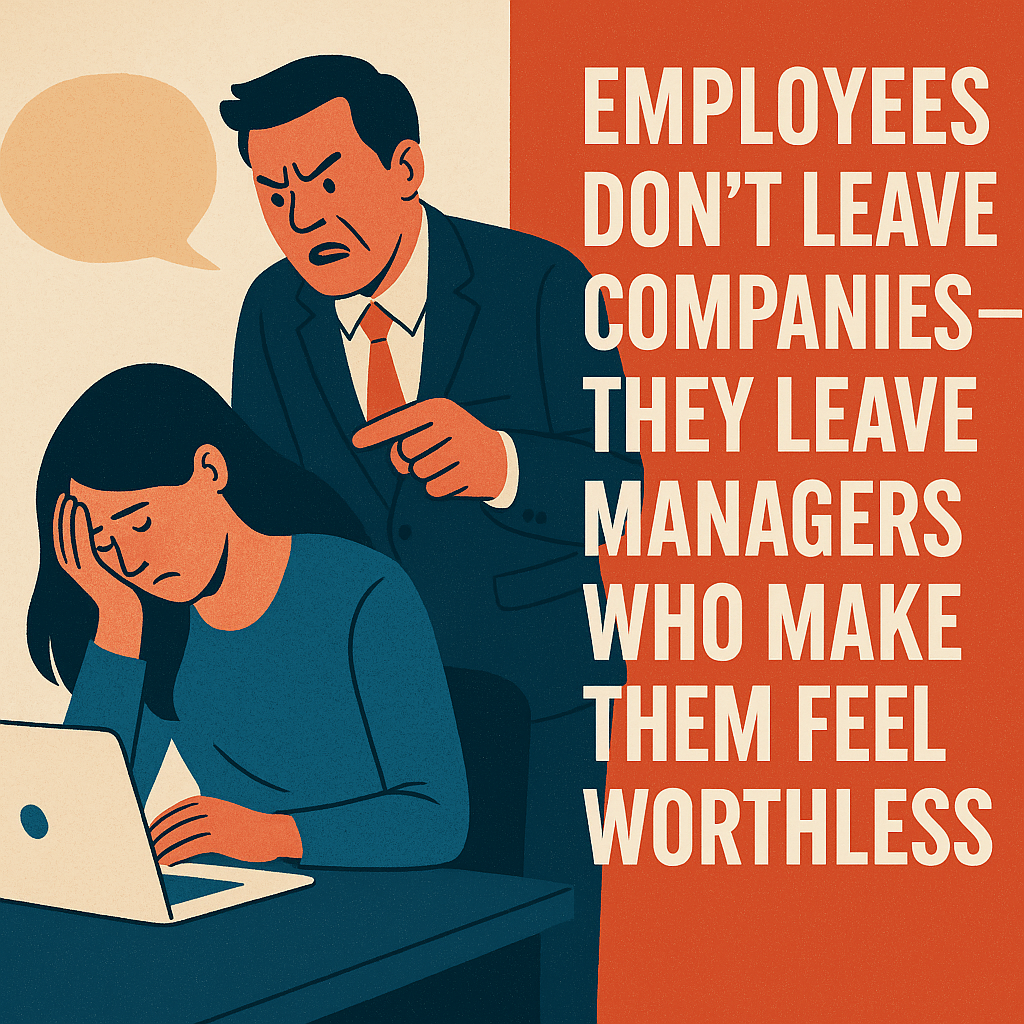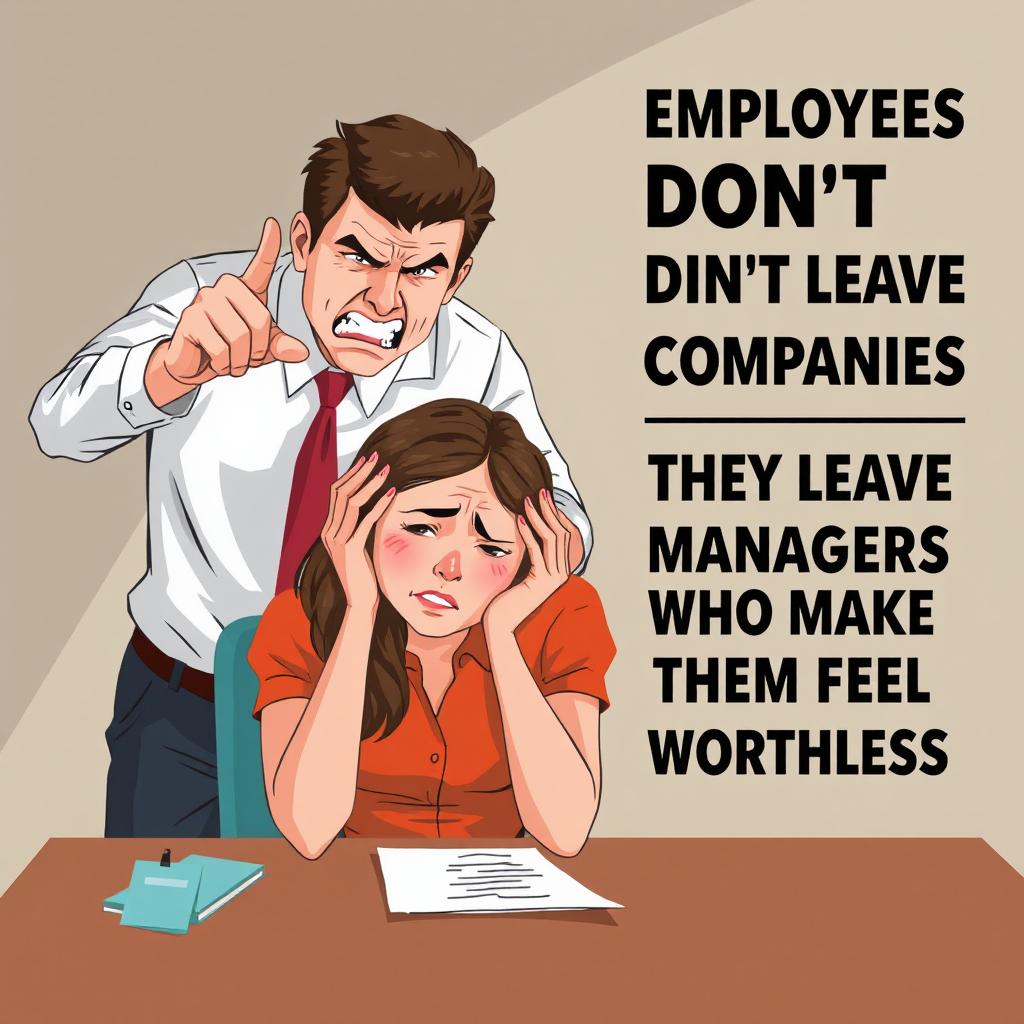⏲️ Estimated reading time: 6 min
Employees Don’t Leave Companies They Leave Managers Who Make Them Feel Worthless
🧠 When employees quit, it’s often not the company they’re escaping it’s the manager. Learn how toxic leadership drives talent away and discover what great managers do to inspire, retain, and empower their teams.
🧭 Introduction: It’s Not the Job, It’s the Manager
Have you ever heard someone say, “I loved my job, but I couldn’t stand my manager”? It’s a sentiment echoed by millions around the globe. While organizations scramble to improve compensation, benefits, and perks, they often overlook one of the most influential factors in employee retention: the manager.
The saying, “Employees don’t leave companies they leave managers,” isn’t just a catchy phrase. It reflects a hard truth backed by research, data, and lived experiences. This article unpacks why poor management is often the true reason employees walk away, the devastating effects of toxic leadership, and how great managers lead teams that stay, grow, and thrive.
🧨 The Myth of Company Loyalty in Today’s Workforce
Gone are the days when loyalty meant a 30-year tenure. Modern professionals crave purpose, growth, and respect. While salary and benefits still matter, they’re not enough to make up for poor leadership.
A 2023 Gallup report revealed that 70% of the variance in employee engagement is tied directly to the manager. So when your team feels disengaged, overworked, or ready to quit it’s likely a leadership issue, not a brand or culture issue.
💥 5 Common Behaviors That Make Employees Feel Worthless
Let’s be clear: most managers don’t intend to demoralize their teams. But poor habits, outdated styles, and lack of training can turn leadership into liability.
1. Micromanagement and Lack of Trust
Hovering managers choke creativity and signal distrust. Employees begin to feel they’re incapable even when they’re not.
2. Lack of Recognition
When only mistakes are acknowledged and wins are ignored, morale plummets. People want to feel seen and valued.
3. Poor Communication
Vague instructions, stonewalling, or lack of transparency breed fear and uncertainty. Teams need clarity, not confusion.
4. Emotional Disregard
A leader with no empathy treats employees like tools, not humans. Ignoring mental health or stress signals destroys team trust.
5. Favoritism and Unfairness
When promotions and praise are handed out based on bias rather than performance, resentment and division follow.
🧠 The Psychological Impact of Toxic Leadership
Toxic managers don’t just create an annoying workday they cause real psychological damage. Employees under poor leadership often suffer:
- Chronic stress and anxiety
- Burnout
- Loss of confidence
- Declining productivity
- Depression and isolation
Left unchecked, these effects become serious health risks, prompting employees to quit not for a better job but for survival.
🌀 How Toxic Managers Harm the Whole Company
One bad manager doesn’t just hurt one employee. They poison the whole organization:
- 🚪 Higher Turnover: Replacing an employee can cost up to 200% of their salary.
- 📉 Low Productivity: Disengaged workers make more errors and contribute less.
- 💔 Damaged Reputation: Negative reviews on Glassdoor or LinkedIn hurt recruitment.
- ⚔️ Team Conflict: Toxicity breeds cliques, gossip, and in-fighting.
🌟 What Great Managers Do Differently
On the flip side, good managers retain talent, boost performance, and build trust. Here’s how:
1. They Trust and Empower
Great managers coach, not control. They hire skilled people and let them do what they do best.
2. They Give Regular, Honest Feedback
Recognition shouldn’t be rare. Good managers constantly acknowledge efforts and offer constructive input.
3. They Set Clear Expectations
Employees shouldn’t have to guess what success looks like. Clarity fuels confidence.
4. They Lead With Emotional Intelligence
Empathy, compassion, and communication make people feel safe and supported.
5. They Support Growth and Career Goals
They invest in development mentoring, training, and aligning personal growth with the company mission.
📖 Real Stories That Prove the Point
🔹 Case Study 1: Crushed Creativity
Julia, a designer, joined a promising startup. But her manager nitpicked every detail and criticized her publicly. “He made me feel like a failure,” she said. She quit after 10 months not because of the company, but because of him.
🔹 Case Study 2: Inspired to Lead
James was ready to leave IT behind burned out and hopeless. Then came Maya, a new team lead. She listened, trusted, and encouraged him. Six months later, James was leading major projects. “She helped me believe in myself again.”

🛠️ How Companies Can Stop Losing Good People to Bad Managers
It’s not ping-pong tables or free coffee that retain employees it’s respect and leadership. Here’s how companies can fix the issue:
Train Managers in Emotional Intelligence
Don’t promote top performers into management without training. Teach empathy, communication, and conflict resolution.
Implement 360-Degree Feedback
Evaluate managers based on feedback from their teams not just on performance metrics.
Promote Based on Values, Not Just KPIs
A great manager isn’t just someone who “gets results.” They build people, too.
Create Safe Reporting Channels
Employees should be able to report abuse or favoritism without fear of retaliation.
Reward Team Builders
Don’t just celebrate sales or revenue. Recognize those who grow others, improve morale, and keep people motivated.
🏃♂️ When Walking Away Is the Strongest Choice
Sometimes the best decision is to leave. If you’re constantly stressed, dismissed, or depleted, it’s okay to walk away. Your well-being matters more than staying loyal to a title or paycheck.
You’re not quitting. You’re reclaiming your peace.

🔁 Let’s Reframe “Retention” to “Respect”
What if we stopped trying to trap employees and started respecting them instead?
Respect their time. Their humanity. Their talent.
Train managers to empower rather than control and you won’t have to beg people to stay. They’ll want to.
💡 Empowering Takeaway
Bad managers cost more than turnover they cost innovation, team spirit, and company credibility. But with intentional leadership and a people-first culture, organizations can thrive.
Let’s stop tolerating leadership that tears people down and start building managers who lift them up.
🔔 For more tutorials like this, consider subscribing to our blog.
📩 Do you have questions or suggestions? Leave a comment or contact us!
🏷️ Tags: employee retention, toxic management, workplace culture, leadership skills, HR management, manager training, job satisfaction, emotional intelligence, career development, team leadership
📢 Hashtags: #EmployeeRetention, #LeadershipMatters, #ToxicManagement, #HRStrategy, #RespectAtWork, #EmployeeEngagement, #WorkplaceCulture, #ManagerTraining, #TeamSuccess, #MentalHealthAtWork
Only logged-in users can submit reports.
Discover more from HelpZone
Subscribe to get the latest posts sent to your email.

